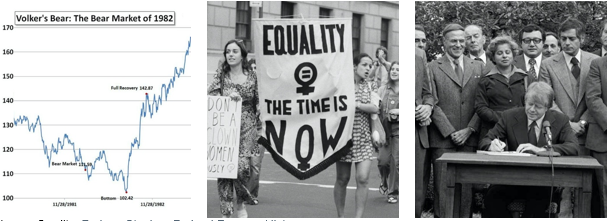Good afternoon, everyone. Whether this is your first Small Business Forum or fortieth, I want to thank you for joining us today and over the course of the week. Planning any 40th event—whether a birthday, anniversary, or work milestone—engenders an element of nostalgia. If this were a birthday party, we might have a slideshow of childhood pictures and play top hits from the year of birth. In planning for this year’s 40th Small Business Forum, our team couldn’t help but think about the original Forum in 1982 and the events that precipitated it. So please humor me today as I paint the picture of then and now, photos and all. The good news for you: unlike a birthday party toast, this one will not trail on and on, leaving you wondering which cousin will take the mic from the loquacious uncle.
A Polaroid Snapshot of 1982

Image Credits: The History Channel, Old Sports Cards, The Guardian
In 1982, the country was in the difficult days of the Cold War, Cal Ripken, Jr. played the first of his record-breaking 2,632 consecutive game streak, and Michael Jackson released Thriller, which went on to become the best-selling album of all time.

Image Credits: Time Magazine, Pinterest, CNET, University of Utah
Technologically, the world was changing rapidly, epitomized by Time magazine naming the personal computer as its “Man of the Year.”[ii] This was the year that the market met technologies like the Commodore 64 home computer,[iii] compact discs (CDs),[iv] and the world’s first artificial heart.[v]

Image Credits: Forbes, Stacker, Federal Reserve History
Economically, the country was reeling from the 1980-82 recession, culminating in the Bear Market of 1982.[vi] The S&P bottomed out on August 12, 1982 at 102.42, and the country was grappling with over 10% unemployment.
Demographically, entrepreneurship and business ownership were beginning to change following legislation passed in the ‘70s. The Equal Credit Opportunity Act of 1974 guaranteed women the right to get a credit card or obtain a loan separately from their spouse, opening the doors to women running their own businesses.[vii] A few years later, the Community Reinvestment Act of 1977 required financial institutions to serve all segments of their communities, improving access to credit for minority entrepreneurs.[viii]
Hitting Fast Forward
Since 1982, quite a lot has changed. As the Time “Machine of the Year” awardee signaled, computer-based technology proliferated, fueled by the growth of venture capital in Silicon Valley.[ix]
Fast forward a few years, in 1996, Congress responded to increasing national capital raising activity with the National Securities Markets Improvement Act (NSMIA) to promote more efficient capital formation, simplifying many aspects of pre-IPO capital raising.[x]
Six year later in 2002, as the public markets were reeling from corporate scandals, Congress passed the Sarbanes-Oxley Act to restore investor confidence in financial markets through increased requirements for independent auditors and public companies.[xi]
Following the Great Recession in the late 2000s, the 2010 Dodd-Frank Wall Street Reform and Consumer Protection Act brought with it a flurry of 67 SEC rulemakings, dozens of studies and reports, and five new offices within the agency.[xii]
Just two years later in 2012, Congress responded to declining numbers of small businesses and public offerings with the Jumpstart Our Business Startups (JOBS) Act, creating a new crowdfunding exemption, carving a pathway for general solicitation offerings sold to verified accredited investors, and encouraging more companies to go public as emerging growth companies.[xiii]
In between those landmark pieces of legislation, the Commission was busy responding to changes in our markets and updating our rules. And each year, you and other members of the public gathered to provide feedback to Congress and the Commission, helping us hone capital formation policy to meet the needs of entrepreneurs and their investors.
Coming Full Circle to Year 40
Undeniably, a lot has changed in the forty years since 1982. Our markets have grown, and “technology” has taken on a whole new meaning.
Yet, much remains the same. Albeit under different circumstances from the early ‘80s, today we are also looking at job losses and fundamental transformations of society, consumer behavior, and business operations in response to COVID-19. One thing remains constant: just as in 1982, we are again looking to entrepreneurs and their investors to lead the charge forward. Case in point: the technologies allowing us to meet virtually throughout this pandemic were built by entrepreneurs, and the vaccines allowing us to exit this pandemic were made possible by our capital markets. Entrepreneurs and their investors are building the future in which we want to live, pushing into new frontiers with solutions we need. It is our job—the public and private sectors working together—to make sure that capital is inclusive, accessible, and scalable for these visionaries. That requires access to capital for startups and angel investors honing their minimum viable product (MVP), for growth-oriented companies and venture investors scaling their business model, and for mature companies and public investors operating with a long-term vision.
Over the next four days of the Forum, we will hear from speakers on timely topics in capital raising, including:
- Monday: Finding Your First Dollars: Navigating Your Way to Raise Early Rounds
- Tuesday: Doing Your Diligence: How Savvy Early-Stage Investors Build Diversified Portfolios
- Wednesday: Diversifying Capital Allocators: Tools for Emerging and Smaller Funds and Their Managers
- Thursday: Small Cap Insights: Perspectives on Smaller Companies
Thank you to our team members for making this event happen: Amy Reischauer, Colin A. Caleb, Dean A. Brazier, Jr., Jenny J. Choi, Jenny Riegel, Jessica W. McKinney, Julie Zelman Davis, Kristene Blake, Malika Sullivan, Sebastian Gomez Abero, and Todd VanLaere, as well as our colleagues across the agency for bringing this virtual event to life, including the Office of Public Affairs, Office of Information Technology, Office of General Counsel, Office of Minority and Women Inclusion, Office of Investor Education and Advocacy, and our colleagues in the different rulemaking divisions.
We are looking to you to help us shape the future of capital raising. Cheers to 40 years of using your voice to positively impact change, and to many more!
[i] The Securities and Exchange Commission disclaims responsibility for any private publication or statement by any of its employees. This speech expresses the author’s views and does not necessarily reflect those of the Commission, the Commissioners, or other members of the staff.
[ii] This edition marked the first time the magazine awarded “Man of the Year” (which it later changed to “Person of the Year”) to a non-human. See http://content.time.com/time/covers/0,16641,19830103,00.html.
[iii] Commodore 64, Wikipedia, (May 17, 2021), available at https://en.wikipedia.org/wiki/Commodore_64.
[iv] See Ryan Waniata, “The Life and Times of the Late, Great CD. Remembering the rise (and final fall) of the late, great Compact Disc,“ digitaltrends, (Feb. 7, 2018) available at https://www.digitaltrends.com/features/the-history-of-the-cds-rise-and-fall/.
[v] Robert Jarvik, MD on the Jarvik-7, Jarvik Heart, (2018), available at https://www.jarvikheart.com/history/robert-jarvik-on-the-jarvik-7/.
[vi] See David John Marotta, “Volker’s Bear: The Bear Market Of 1982,” Forbes, (Oct. 11, 2017), available at https://www.forbes.com/sites/davidmarotta/2017/10/11/volkers-bear-the-bear-market-of-1982/.
[vii] See Carol Tice, “The American Business Revolution,” Entrepreneur, (April 18, 2007), available at https://www.entrepreneur.com/article/177302.
[viii] Id.
[ix] Venture capital, Wikipedia, (May 19, 2021), available at https://en.wikipedia.org/wiki/Venture_capital#1980s.
[x] See ABA Business Law Section, “National Securities Markets Improvement Act of 1996,” American Bar Association,“ (May 14, 2020), available at https://www.americanbar.org/groups/business_law/publications/the_business_lawyer/find_by_subject/buslaw_tbl_mci_nsmia/.
[xi] The Laws That Govern the Securities Industry, U.S. Securities & Exchange Commission, Investor.gov, (May 19, 2021), available at https://www.investor.gov/introduction-investing/investing-basics/role-sec/laws-govern-securities-industry.
[xii] Implementing the Dodd-Frank Wall Street Reform and Consumer Protection Act, U.S. Securities & Exchange Commission, (Dec. 23, 2020), available at https://www.sec.gov/spotlight/dodd-frank.shtml.
[xiii] See supra note 11.








